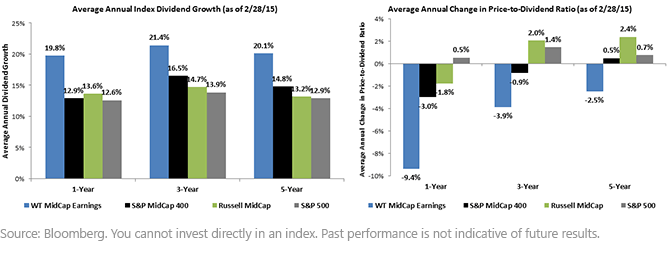How This Mid Cap Index Became Less Pricey Despite Strong Gains


 • WT MidCap Earnings Index Growing Dividends at 20% per Year: This is the classic case of an index where the returns have been strong, but the dividend growth has been stronger. The result? The price-to-dividend ratio actually decreased over the past one-, three- and five-year periods.
• Mid-Cap Dividend Growth Outpaces S&P 500 Dividend Growth: Each of the mid-cap indexes shown had dividend growth faster than that of the S&P 500 Index over the past one-, three- and five-year periods. Large-cap and small-cap equities certainly get significant attention, but the strong levels of dividend growth are one reason we think mid-caps can also be exciting.
Follow the Fundamentals
The WisdomTree MidCap Earnings Index takes an approach that emphasizes following the fundamentals, as every constituent must prove its profitability at each annual Index screening. While the Index doesn’t require every constituent to be a dividend payer, the dividend growth that it has displayed over its performance history has been impressive.
1Source: Bloomberg, for five-year period ending 2/28/15.
2Source for all bullets: Bloomberg, for five-year period ending 2/28/15.
3WisdomTree MidCap Earnings Index standardized average annual returns as of 2/28/15: one-year return: 10.2%; three-year return: 18.4%; since-inception return: 10.5%. Inception date: 2/1/07.
4S&P MidCap 400 Index standardized average annual returns as of 2/28/15: one-year return: 11.1%; three-year return: 17.2%; since WT MidCap Earnings Index inception return: 9.2%.
5Russell Midcap Index standardized average annual returns as of 2/28/15: one-year return: 13.3%; three-year return: 18.9%; since WT MidCap Earnings Index inception return: 8.5%.
6Source: Bloomberg, for five-year period ending 2/28/15.
• WT MidCap Earnings Index Growing Dividends at 20% per Year: This is the classic case of an index where the returns have been strong, but the dividend growth has been stronger. The result? The price-to-dividend ratio actually decreased over the past one-, three- and five-year periods.
• Mid-Cap Dividend Growth Outpaces S&P 500 Dividend Growth: Each of the mid-cap indexes shown had dividend growth faster than that of the S&P 500 Index over the past one-, three- and five-year periods. Large-cap and small-cap equities certainly get significant attention, but the strong levels of dividend growth are one reason we think mid-caps can also be exciting.
Follow the Fundamentals
The WisdomTree MidCap Earnings Index takes an approach that emphasizes following the fundamentals, as every constituent must prove its profitability at each annual Index screening. While the Index doesn’t require every constituent to be a dividend payer, the dividend growth that it has displayed over its performance history has been impressive.
1Source: Bloomberg, for five-year period ending 2/28/15.
2Source for all bullets: Bloomberg, for five-year period ending 2/28/15.
3WisdomTree MidCap Earnings Index standardized average annual returns as of 2/28/15: one-year return: 10.2%; three-year return: 18.4%; since-inception return: 10.5%. Inception date: 2/1/07.
4S&P MidCap 400 Index standardized average annual returns as of 2/28/15: one-year return: 11.1%; three-year return: 17.2%; since WT MidCap Earnings Index inception return: 9.2%.
5Russell Midcap Index standardized average annual returns as of 2/28/15: one-year return: 13.3%; three-year return: 18.9%; since WT MidCap Earnings Index inception return: 8.5%.
6Source: Bloomberg, for five-year period ending 2/28/15. 
Christopher Gannatti began at WisdomTree as a Research Analyst in December 2010, working directly with Jeremy Schwartz, CFA®, Director of Research. In January of 2014, he was promoted to Associate Director of Research where he was responsible to lead different groups of analysts and strategists within the broader Research team at WisdomTree. In February of 2018, Christopher was promoted to Head of Research, Europe, where he was based out of WisdomTree’s London office and was responsible for the full WisdomTree research effort within the European market, as well as supporting the UCITs platform globally. In November 2021, Christopher was promoted to Global Head of Research, now responsible for numerous communications on investment strategy globally, particularly in the thematic equity space. Christopher came to WisdomTree from Lord Abbett, where he worked for four and a half years as a Regional Consultant. He received his MBA in Quantitative Finance, Accounting, and Economics from NYU’s Stern School of Business in 2010, and he received his bachelor’s degree from Colgate University in Economics in 2006. Christopher is a holder of the Chartered Financial Analyst Designation.

